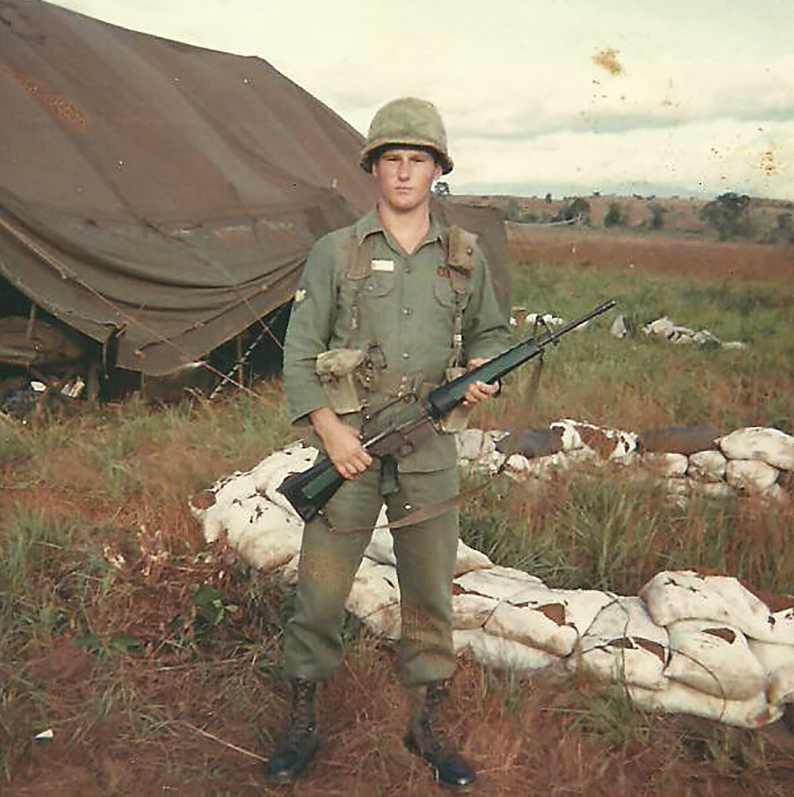I joined the Army on June 27, 1965, at age 17, two weeks after I graduated high school in Newport, Ky. I went through basic training at Fort Knox, Ky., and took AIT at Fort Dix, N.J., where I trained as heavy weapons infantry. I qualified with the M40 106mm jeep-mounted recoilless rifle, the M67 90mm recoilless rifle, and the 3.5-inch Bazooka rocket launcher.
I went through jump school at Fort Benning, Ga., and was sent to the 101st Airborne Division at Fort Campbell, Ky. I went weekly to the captain’s office and asked to be sent to Vietnam, until finally I was called to his office and told that I would be going. I was first assigned to the 4th Infantry Division at Fort Lewis, Wash. Once there I was assigned to Company C, 1st Battalion, 22nd Infantry, 4th Infantry Division. My job was to be a gunner on the 106mm recoilless rifle.
We left in July 1966 for a 17-day trip on the USNS General Nelson M. Walker transport ship. After arriving in country, we spent about a month digging bunkers for our future base camp in the Pleiku area. Our first operation, Operation Seward, took place in the vicinity of Tuy Hoa. My 106mm recoilless rifle squad consisted of our squad leader, a Sgt. E5, a PFC driver, a Spec 4 assistant gunner, and myself, the gunner, then a Spec 4. Our first assignment was to guard engineers running a water purification plant on a river next to a bridge on Highway 1. Most of the area consisted of rice paddies.
Over a mile away loomed a large mountain we soon named Purple Heart Mountain—our company had several soldiers killed on missions around that summit. In fact, one of my best friends was killed on Sept. 27, 1966.
Several weeks later, we were at the water purification site listening to the radio when we heard second platoon in a firefight. I looked through the scope on the 106 and could see Purple Heart Mountain. In the middle of the mountain, about two-thirds of the way up, I observed three Viet Cong coming out of a cave.
The VC pulled a machine gun mounted on a wheeled cart, using this improvised device to shoot down at our soldiers while using the cave as a hiding place. When, eventually, helicopter gunships came and tried to take out the machine gun, the VC ran back into the cave only to come back out after the helicopters left. Then jets were called; they also attempted to take out the machine gun, but the VC again hid inside the cave and came back out to fire at our soldiers after the jets left.
I told my squad sergeant I thought I could fire a 106 round into the cave. He got on the radio and I was given permission to try.
The 106mm recoilless rifle is a flat-trajectory weapon and its main purpose is to engage tanks. In Vietnam, it was used to take out bunkers and even buildings. To fire a round into the cave, I had to elevate the recoilless rifle upward and fire the round in an arcing trajectory, more like an artillery piece. I could line the shot up perfectly vertically but had to guess horizontally. Once I had the shot lined up, we loaded a 35-pound white phosphorus round into the gun.
I fired the 106. Looking through the scope, I could see the round traveling in the air and watched it fly over the mountain. We reloaded another white phosphorous round. This time I cranked the gun down two clicks and fired the second round. I saw it fly through the air, and this time I saw it go directly in the cave. Observing for about 30 minutes, we saw that no one came out of the cave.
A little while later, I saw soldiers from the second platoon on the mountain near the cave. The following day, I asked a guy from second platoon if they went into the cave and if I had taken out the VC machine gun crew. He said they could not go inside the cave due to the white phosphorous, but could smell the burnt hair and flesh. That was a very unusual way to use a 106 recoilless rifle, but it did the job.
In October we were moved to the jungles of the Central Highlands. Since there were no roads, I was assigned as a squad leader on the 81mm mortars. I did not like that job and soon volunteered to go out with the infantry as a forward observer for the mortars.
On Feb. 16, 1967, I was wounded while taking part in Operation Sam Houston in Kontum Province. After recovering from my wound, I taught basic trainees at Fort Knox. I was promoted to Staff Sgt. E6 while there. I served in the Army for three years.
historynet magazines
Our 9 best-selling history titles feature in-depth storytelling and iconic imagery to engage and inform on the people, the wars, and the events that shaped America and the world.







